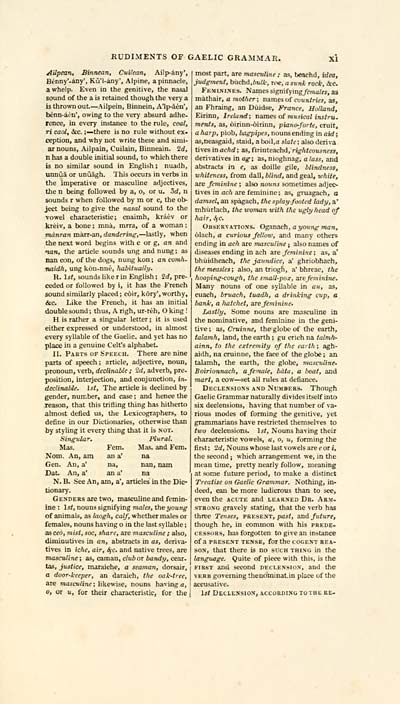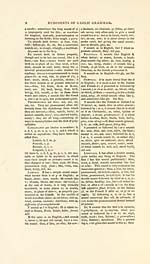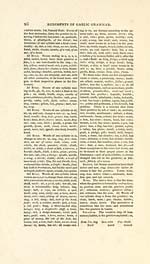Download files
Complete book:
Individual page:
Thumbnail gallery: Grid view | List view

RUDIMENTS OF GAELIC GRAMMAR.
XI
Ailpean, Binnean, CuVean, Ailp-àny',
Bènny'-àny', Kù'l-àny', Alpine, a pinnacle,
a whelp. Even in the genitive, the nasal
sound of the a is retained though the very a
is thrown out. — Ailpein, Binnein, A'lp-àèn',
bènn-à(-n', owing to the very absurd adhe-
rence, in every instance to the rule, coal,
ri caol, &c. ;— there is no rule without ex.
ception, and why not write these and simi-
ar nouns, Ailpain, Cuilain, Binneain. 2rf,
n has a double initial sound, to which there
is no similar sound in English ; nuadb,
unnùà or unùàgh. This occurs in verbs in
the imperative or masculine adjectives,
the n being followed by a, o, or u. òd, n
sounds r when followed by m or c, the ob-
ject being to give the nasal sound to the
vowel characteristic; cnaimh, kràèv or
krèiv, a bone ; mna, mrra, of a woman ;
mànran màrr-an, danderìjis, — lastly, when
the next word begins with c or g, an and
•tan, the article sounds ung and nung ; as
nan con, of the dogs, nung kon ; an Qomh.
■naidh, ung kòn-nnè, habitually.
R. \st, sounds like r in English; 2rf, pre-
ceded or followed by i, it has the French
sound similarly placed; coir, kory', worthy,
&c. Like the French, it has an initial
double sound; thus, A righ, ur-rèh, O king !
H is rather a singular letter ; it is used
either expressed or understood, in almost
every syllable of the Gaelic, and yet has no
place in a genuine Celt's alphabet.
n. Pabts OF Speech. There are nine
parts of speech; article, adjective, noun,
pronoun, verb, declinable ; -d, adverb, pre-
position, interjection, and conjunction, in-
declinable. 1st, The article is declined by
gender, number, and case ; and hence the
reason, that this trifling thing has hitherto
almost defied us, the Lexicographers, to
define in our Dictionaries, otherwise than
by styling it every thing that it is not.
Singular. Plural.
Mas. Fern. Mas. and Fem.
Nom. An, am an a' na
Gen. An, a' na, nan, nam
Dat. An, a' an a' na
N. B. See An, am, a', articles in the Dic-
tionary.
Gexders are two, masculine and femin-
ine : 1st, nouns signifying males, the young
of animals, as laogh, calf, whether males or
females, nouns having o in the last syllable ;
as ceo, mist, soc, share, are masculine ; also,
diminutives in an, abstracts in as, deriva-
tives in iche, air, SjC. and native trees, are
Tnasculine ; as, caman, club or bandy, cear.
tas, justice, maraiehe, a seaman, dorsair,
a door-keeper, an daraich, the oak-tree,
are ma.scu/Ì7ie; likewise, nouns having a,
0, or u, for their characteristic, for the |
most part, are masailine ; as, fjeaehd, idea,
judgment, hixchA.bulk, roc, a sunk rock, ic.
Femi.m.nes. Names signifying/fmato, as
mathair, a mother; na-meutt countries, as,
an Fhraing, an Duidse, France, Holland,
Eirinn, Ireland; names of musical instru.
ments, as, òirinn-òirinn, piano-forte, cruit,
a harp, piob, bagpipes, nouns ending in aid;
as.neasgaid, staid, aboil, a slate; alsoderiva
tives in achd; as, firinteachd, righteousness,
derivatives in a^; as, nioghnag, a lass, and
abstracts in e, as doille gile, blindness,
whiteness, from dall, blind, and geal, white,
are feminine ; also nouns sometimes adjec-
tives in ac/i are feminine; as, gruagach, a
damsel, an spagach, the splayfooted lady, a'
mhiirlach, the woman with the ugly head of
hair, 4c.
Observations. Oganach, a young man,
òlach, a curious fellow, and many others
ending in ach are masculine j also names of
diseases ending in ach are feminine; as, a'
bhuidheach, the jaundice, a' ghriobhach,
the measles; also, an triogh, a* bhreac, the
hooping-cough, the small-por, aiefeminxne.
Many nouns of one syllable in au, as,
cuach, bruach, tuadh, a drinking cup, a
bank, a hatchet, are feminine.
Lastly, Some nouns are masculine in
the nominative, and feminine in the geni-
tive; as, Cruinne, the globe of the earth,
talamh, land, the earth ; gu cnch na talm/i-
ainn, to the extremity of the earth; agh-
aidh, na cruinne, the face of the globe ; an
talamh, the earth, the globe, masculine.
Boirionnach, afemale, bàta, a boat, and
mart, a cow — set all rules at defiance.
Declensions and Numbers. Though
Gaelic Grammar naturally divides itself into
six declensions, having that number of va-
rious modes of forming the genitive, yet
grammarians have restricted themselves to
two declensions. 1^/, Nouns having their
characteristic vowels, a, o, u, forming the
first ; '2d, Nouns whose last vowels are e or »,
the second j which arrangement we, in the
mean time, pretty nearly follow, meaning
at some future period, to make a distinct
Treatise on Gaelic Grammar. Nothing, in-
deed, can be more ludicrous than to see,
even the acute and learned Dr. Arm.
STRONG gravely stating, that the verb has
three Tenses, present, past, and future,
though he, in common with his prede.
cessors, has forgotten to give an instance
of a present tense, for the cogent rea-
son, that there is no such thing in the
language. Quite of piece with this, is the
first and second declension, and the
verb governing thenominatin place of the
\st Declension, according to t
XI
Ailpean, Binnean, CuVean, Ailp-àny',
Bènny'-àny', Kù'l-àny', Alpine, a pinnacle,
a whelp. Even in the genitive, the nasal
sound of the a is retained though the very a
is thrown out. — Ailpein, Binnein, A'lp-àèn',
bènn-à(-n', owing to the very absurd adhe-
rence, in every instance to the rule, coal,
ri caol, &c. ;— there is no rule without ex.
ception, and why not write these and simi-
ar nouns, Ailpain, Cuilain, Binneain. 2rf,
n has a double initial sound, to which there
is no similar sound in English ; nuadb,
unnùà or unùàgh. This occurs in verbs in
the imperative or masculine adjectives,
the n being followed by a, o, or u. òd, n
sounds r when followed by m or c, the ob-
ject being to give the nasal sound to the
vowel characteristic; cnaimh, kràèv or
krèiv, a bone ; mna, mrra, of a woman ;
mànran màrr-an, danderìjis, — lastly, when
the next word begins with c or g, an and
•tan, the article sounds ung and nung ; as
nan con, of the dogs, nung kon ; an Qomh.
■naidh, ung kòn-nnè, habitually.
R. \st, sounds like r in English; 2rf, pre-
ceded or followed by i, it has the French
sound similarly placed; coir, kory', worthy,
&c. Like the French, it has an initial
double sound; thus, A righ, ur-rèh, O king !
H is rather a singular letter ; it is used
either expressed or understood, in almost
every syllable of the Gaelic, and yet has no
place in a genuine Celt's alphabet.
n. Pabts OF Speech. There are nine
parts of speech; article, adjective, noun,
pronoun, verb, declinable ; -d, adverb, pre-
position, interjection, and conjunction, in-
declinable. 1st, The article is declined by
gender, number, and case ; and hence the
reason, that this trifling thing has hitherto
almost defied us, the Lexicographers, to
define in our Dictionaries, otherwise than
by styling it every thing that it is not.
Singular. Plural.
Mas. Fern. Mas. and Fem.
Nom. An, am an a' na
Gen. An, a' na, nan, nam
Dat. An, a' an a' na
N. B. See An, am, a', articles in the Dic-
tionary.
Gexders are two, masculine and femin-
ine : 1st, nouns signifying males, the young
of animals, as laogh, calf, whether males or
females, nouns having o in the last syllable ;
as ceo, mist, soc, share, are masculine ; also,
diminutives in an, abstracts in as, deriva-
tives in iche, air, SjC. and native trees, are
Tnasculine ; as, caman, club or bandy, cear.
tas, justice, maraiehe, a seaman, dorsair,
a door-keeper, an daraich, the oak-tree,
are ma.scu/Ì7ie; likewise, nouns having a,
0, or u, for their characteristic, for the |
most part, are masailine ; as, fjeaehd, idea,
judgment, hixchA.bulk, roc, a sunk rock, ic.
Femi.m.nes. Names signifying/fmato, as
mathair, a mother; na-meutt countries, as,
an Fhraing, an Duidse, France, Holland,
Eirinn, Ireland; names of musical instru.
ments, as, òirinn-òirinn, piano-forte, cruit,
a harp, piob, bagpipes, nouns ending in aid;
as.neasgaid, staid, aboil, a slate; alsoderiva
tives in achd; as, firinteachd, righteousness,
derivatives in a^; as, nioghnag, a lass, and
abstracts in e, as doille gile, blindness,
whiteness, from dall, blind, and geal, white,
are feminine ; also nouns sometimes adjec-
tives in ac/i are feminine; as, gruagach, a
damsel, an spagach, the splayfooted lady, a'
mhiirlach, the woman with the ugly head of
hair, 4c.
Observations. Oganach, a young man,
òlach, a curious fellow, and many others
ending in ach are masculine j also names of
diseases ending in ach are feminine; as, a'
bhuidheach, the jaundice, a' ghriobhach,
the measles; also, an triogh, a* bhreac, the
hooping-cough, the small-por, aiefeminxne.
Many nouns of one syllable in au, as,
cuach, bruach, tuadh, a drinking cup, a
bank, a hatchet, are feminine.
Lastly, Some nouns are masculine in
the nominative, and feminine in the geni-
tive; as, Cruinne, the globe of the earth,
talamh, land, the earth ; gu cnch na talm/i-
ainn, to the extremity of the earth; agh-
aidh, na cruinne, the face of the globe ; an
talamh, the earth, the globe, masculine.
Boirionnach, afemale, bàta, a boat, and
mart, a cow — set all rules at defiance.
Declensions and Numbers. Though
Gaelic Grammar naturally divides itself into
six declensions, having that number of va-
rious modes of forming the genitive, yet
grammarians have restricted themselves to
two declensions. 1^/, Nouns having their
characteristic vowels, a, o, u, forming the
first ; '2d, Nouns whose last vowels are e or »,
the second j which arrangement we, in the
mean time, pretty nearly follow, meaning
at some future period, to make a distinct
Treatise on Gaelic Grammar. Nothing, in-
deed, can be more ludicrous than to see,
even the acute and learned Dr. Arm.
STRONG gravely stating, that the verb has
three Tenses, present, past, and future,
though he, in common with his prede.
cessors, has forgotten to give an instance
of a present tense, for the cogent rea-
son, that there is no such thing in the
language. Quite of piece with this, is the
first and second declension, and the
verb governing thenominatin place of the
\st Declension, according to t
Set display mode to: Large image | Transcription
Images and transcriptions on this page, including medium image downloads, may be used under the Creative Commons Attribution 4.0 International Licence unless otherwise stated. ![]()
| Early Gaelic Book Collections > Blair Collection > Argyleshire pronouncing Gaelic dictionary > (15) |
|---|
| Permanent URL | https://digital.nls.uk/76240071 |
|---|
| Description | A selection of books from a collection of more than 500 titles, mostly on religious and literary topics. Also includes some material dealing with other Celtic languages and societies. Collection created towards the end of the 19th century by Lady Evelyn Stewart Murray. |
|---|
| Description | Selected items from five 'Special and Named Printed Collections'. Includes books in Gaelic and other Celtic languages, works about the Gaels, their languages, literature, culture and history. |
|---|

